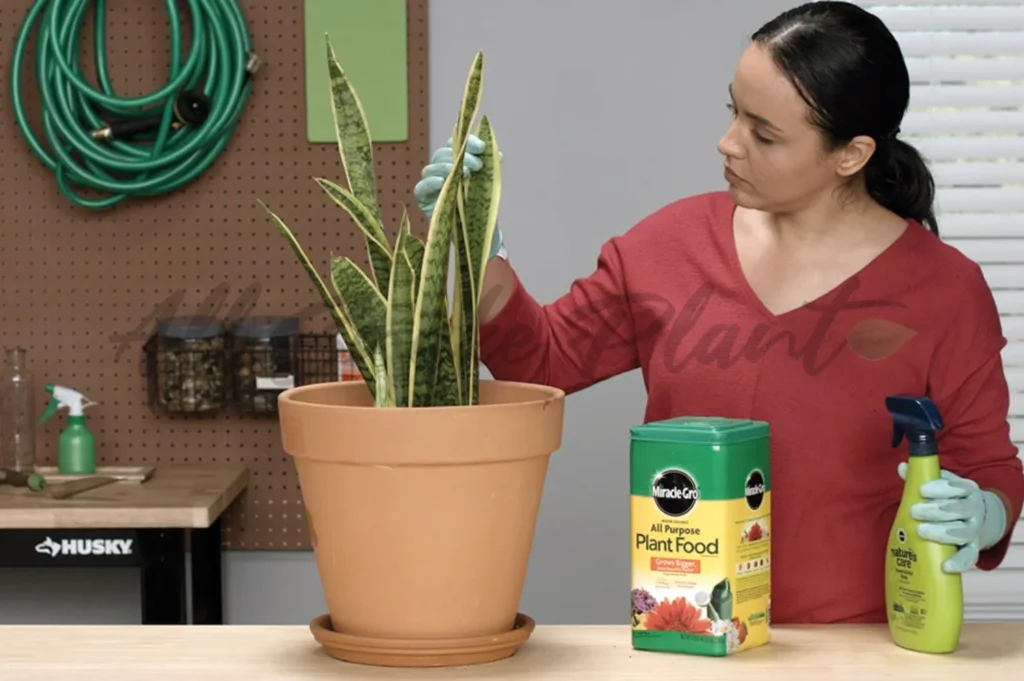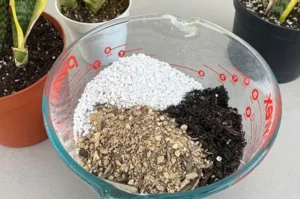Snake plants are known for being strong, easy to care for, and beautiful. They can grow with little attention, but if you want your plant to be its healthiest, fertilizing it properly is important. In this article, you’ll learn the right way to fertilize a snake plant without any confusion or guesswork.
According to the Penn State Extension, for a more robust plant, fertilize monthly during the growing season with an all-purpose fertilizer at half strength.
Why Fertilizer Helps Snake Plants Thrive
Even though snake plants can survive in poor soil, adding fertilizer can give them the boost they need. Over time, the nutrients in the soil wear out, especially in pots. Fertilizing helps your plant get the extra food it needs to grow better and look fresher.
Benefits of Fertilizing:
- Encourages new leaf growth
- Improves leaf color and strength
- Supports healthy root development
- Makes the plant more resistant to stress or pests
When Should You Fertilize a Snake Plant?
The ideal time to fertilize is during the active growing season — that means spring and summer. During these months, the plant grows faster and uses more energy, so it benefits from added nutrients.
Avoid fertilizing in fall and winter when the plant rests. Feeding it during dormancy can cause more harm than good.
How Frequently to Fertilize
Snake plants don’t need fertilizer all the time. In most cases, feeding them once every 4 to 6 weeks during the growing season is enough.
If your snake plant is in low light or growing slowly, reduce feeding to once every 2 months.
Choosing the Right Fertilizer
Not all fertilizers are the same. Snake plants prefer a balanced or low-strength formula. Here are some options:
1. General Houseplant Fertilizer
A balanced liquid fertilizer like 10-10-10 or 20-20-20 works well. It provides nitrogen, phosphorus, and potassium — the three main nutrients.
2. Cactus and Succulent Fertilizer
These fertilizers are lighter and made for plants that don’t need much feeding, which fits snake plants perfectly.
3. Organic Choices
Natural fertilizers like compost tea, seaweed extract, or worm castings add nutrients gently and also improve the soil over time.
How to Fertilize: Step-by-Step Instructions
Follow these easy steps to fertilize your snake plant safely:
Step 1: Pick Your Fertilizer
Use a fertilizer suited for indoor plants or succulents. Liquid types are easiest to use.
Step 2: Mix with Water
Always dilute the fertilizer as instructed. For snake plants, it’s smart to use half the recommended amount to avoid overfeeding.
Step 3: Water the Plant First
Before adding fertilizer, lightly water the soil. This helps protect the roots from getting burned.
Step 4: Apply to the Soil
Gently pour the diluted fertilizer around the base of the plant. Try to avoid pouring on the leaves.
Step 5: Clean Any Spills
If any fertilizer gets on the plant, wipe it off to avoid damage or spotting.

Signs That Your Snake Plant Needs Fertilizer
Here are some signs your plant might need extra nutrients:
- Leaves are lighter green or yellowing
- Growth is very slow in spring or summer
- Leaves are drooping or soft
- Roots are weak or not spreading
Before fertilizing, make sure the plant is getting the right light and water. Sometimes the problem is not nutrition but poor care.

What Happens If You Use Too Much Fertilizer?
Overfeeding your snake plant can cause more harm than good. Watch out for:
- Brown or crispy leaf tips
- Salt buildup on top of the soil
- Yellowing leaves
- Root rot or weak growth
If you’ve added too much, flush the pot with plain water a few times to remove the excess fertilizer.
Homemade and Natural Fertilizers
If you prefer natural options, here are a few gentle methods:
1. Banana Water
Soak chopped banana peels in water for two days. The potassium-rich water can help feed your plant.
2. Eggshell Soak
Place crushed eggshells in water overnight. The water adds calcium to the soil when poured around the base.
3. Used Coffee Grounds
Dry and sprinkle a small amount of used coffee grounds into the soil. Use this sparingly to avoid over-acidity.
Use these natural methods only once in a while, and always test in small amounts first.
Conclusion
Fertilizing a snake plant is easy when you follow a simple routine. Don’t overdo it, a little care goes a long way.
Quick Summary:
- Fertilize once a month during spring and summer
- Skip fertilizer in fall and winter
- Use mild, diluted fertilizer
- Avoid overfeeding
- Try natural fertilizers if you prefer organic care
With the right approach, your snake plant will stay strong, fresh, and full of life all year long.







2 thoughts on “How to Fertilize Snake Plant”
Thank you for this hint. Many indoor plants don’t really need regular fertilisation. I find it better to replace the soil in their pots every year or whenever I notice some salt accumulation on top. However in pots containing large size plants, it’s good Idea to supply the plants with foliar nutrition every now and then, particularly if changing rooting media is not that easy.
Thanks for the tip. I’m new in growing the snake plant and I was not sure if what or how to care for it
Now I have learned something and am looking forward to watch my plant grow healthy